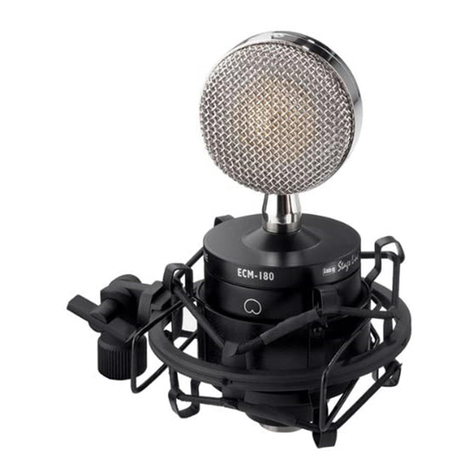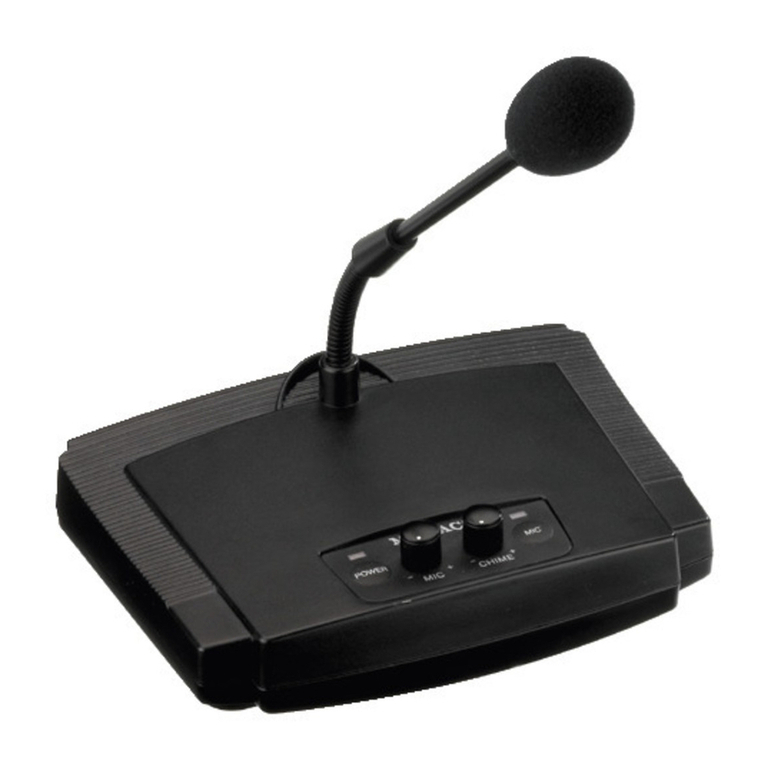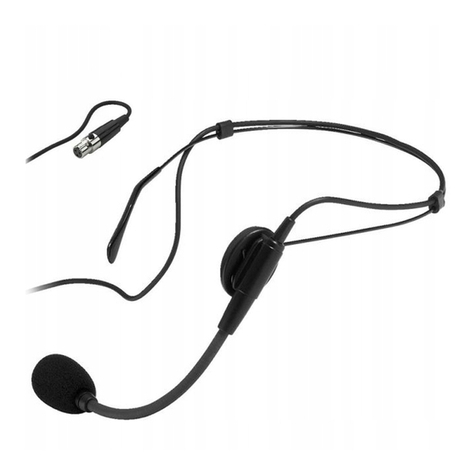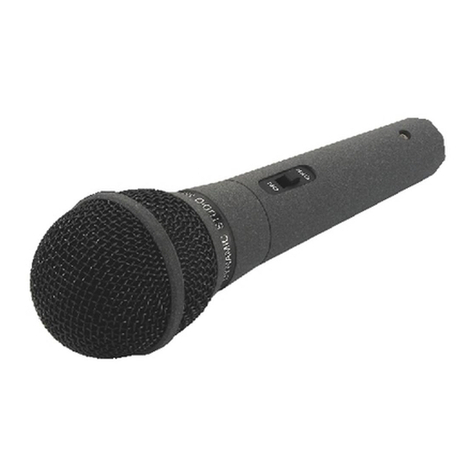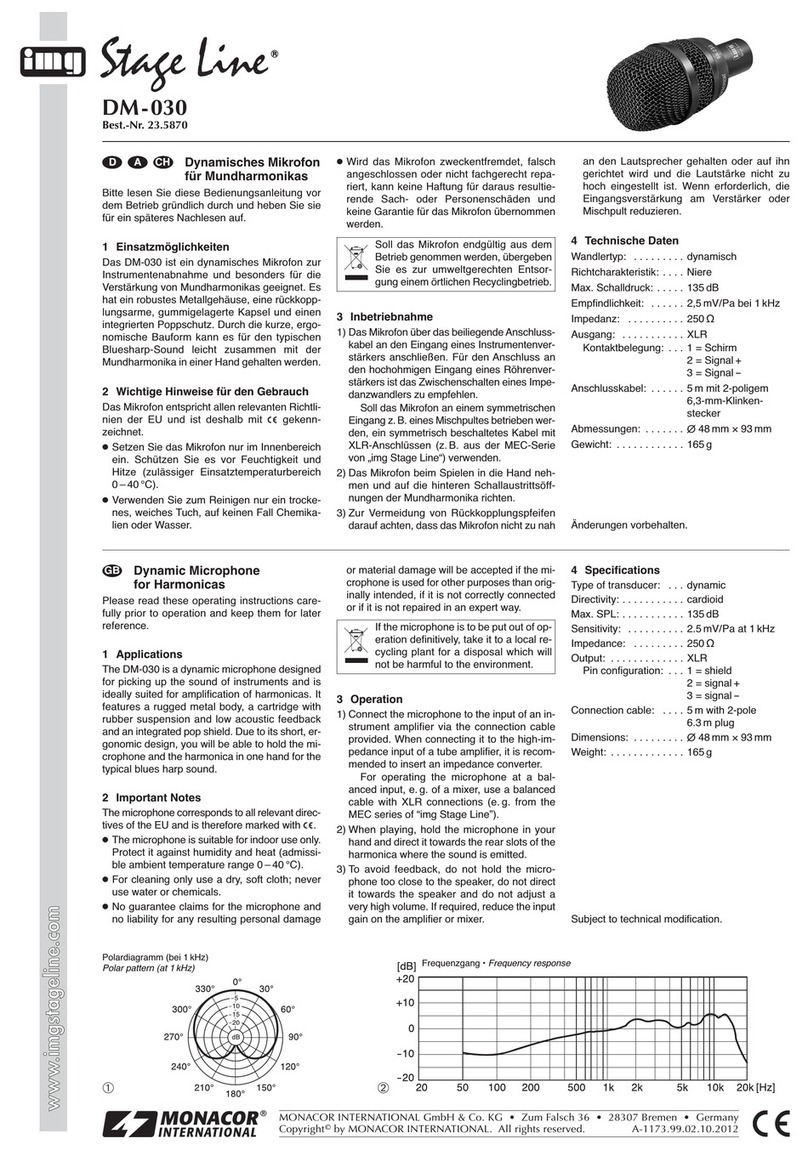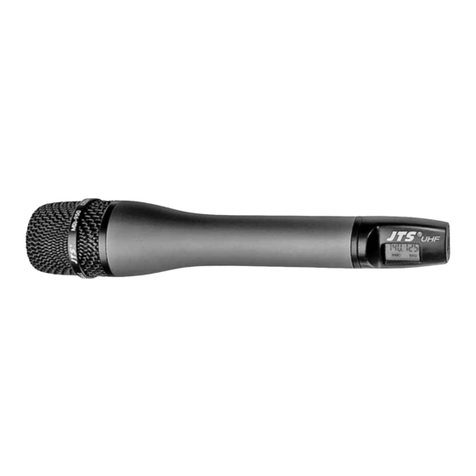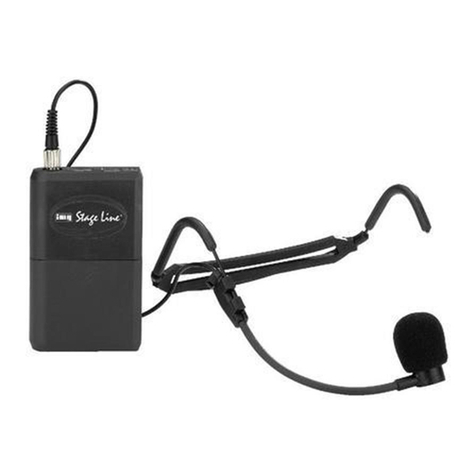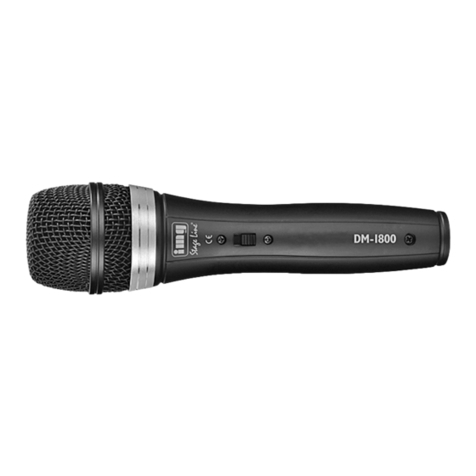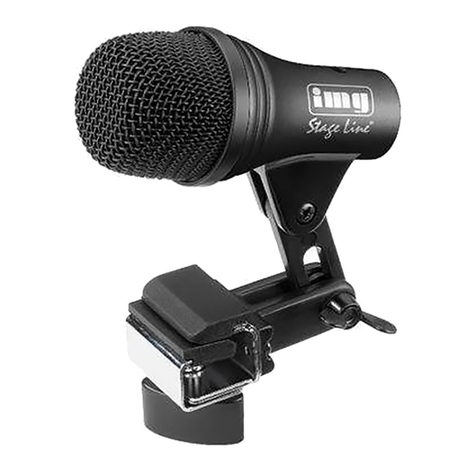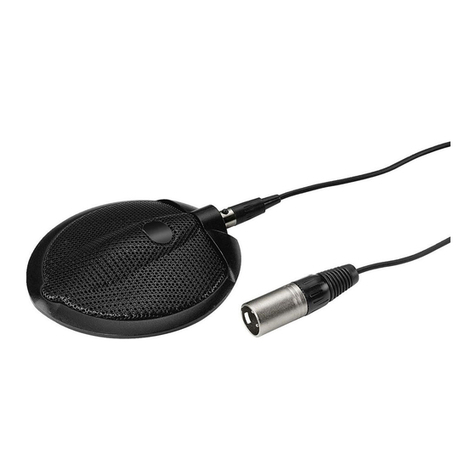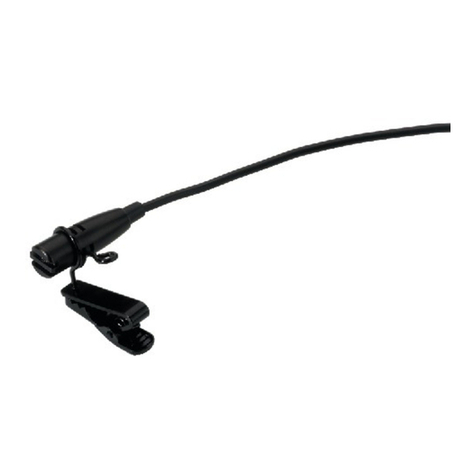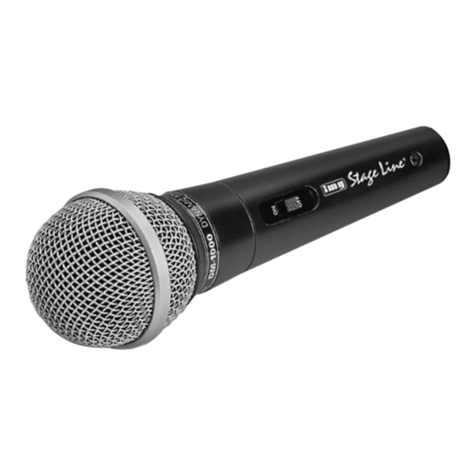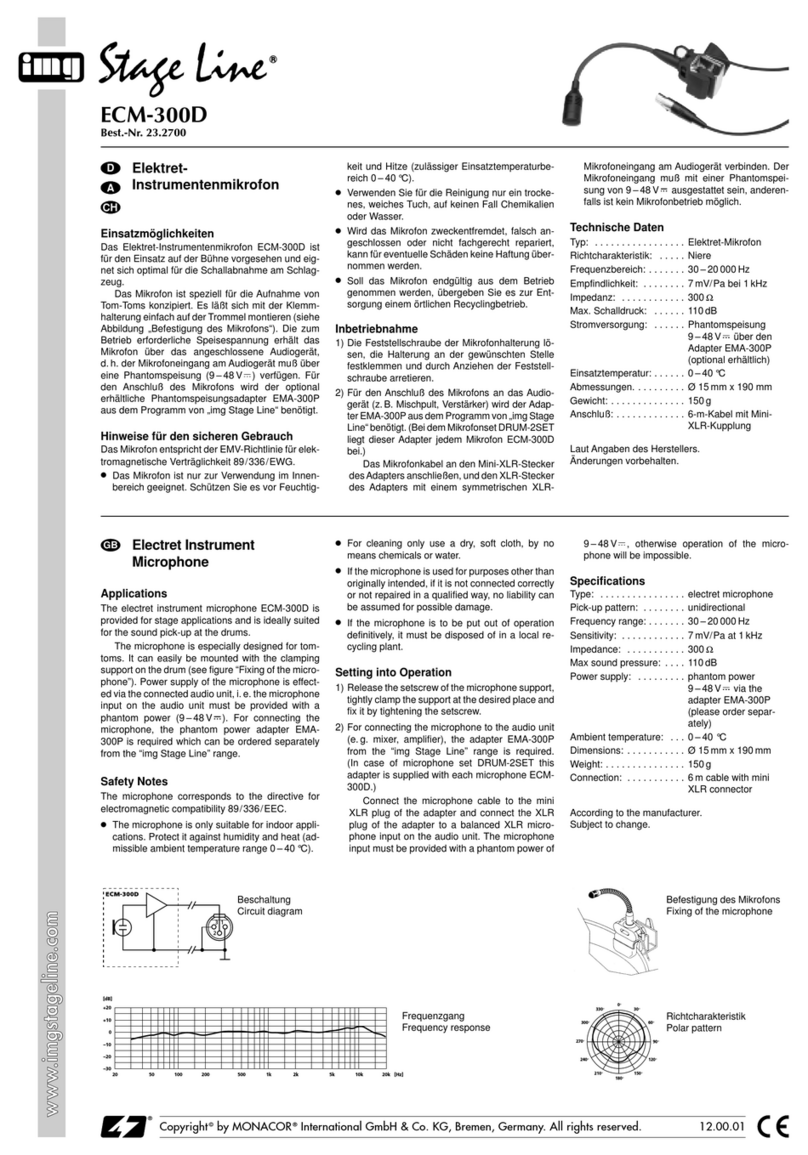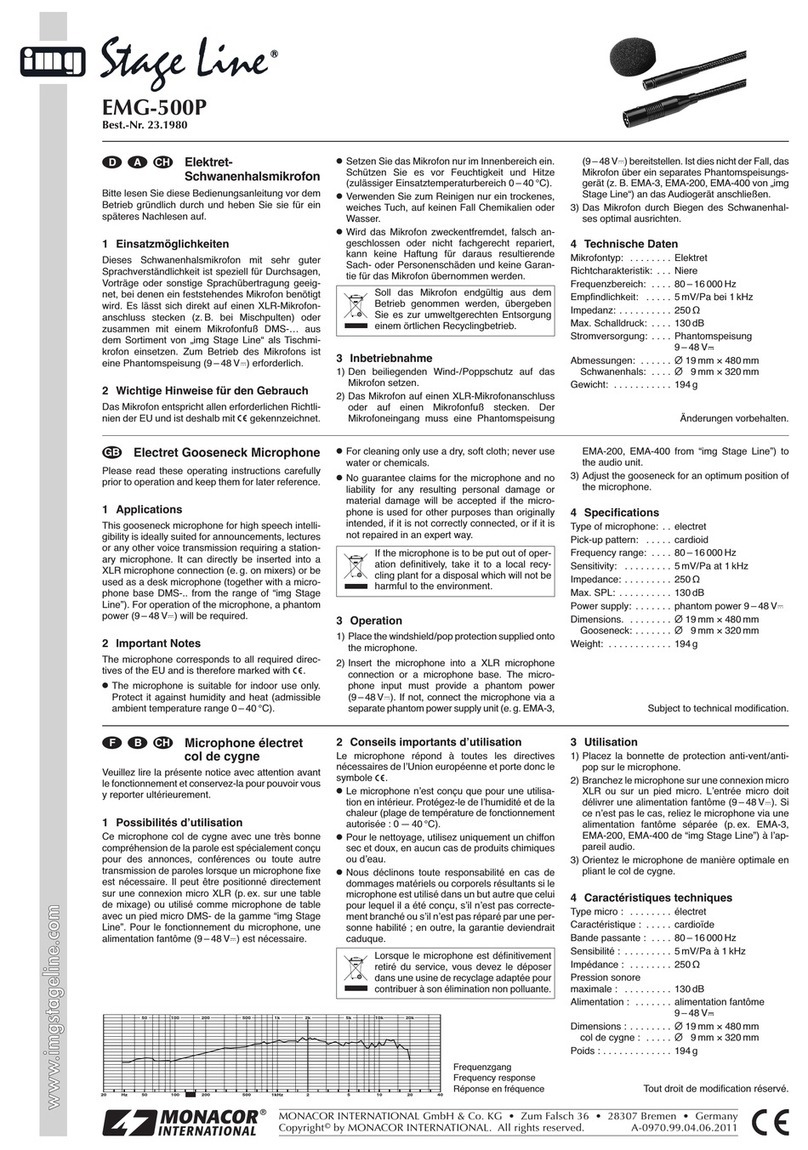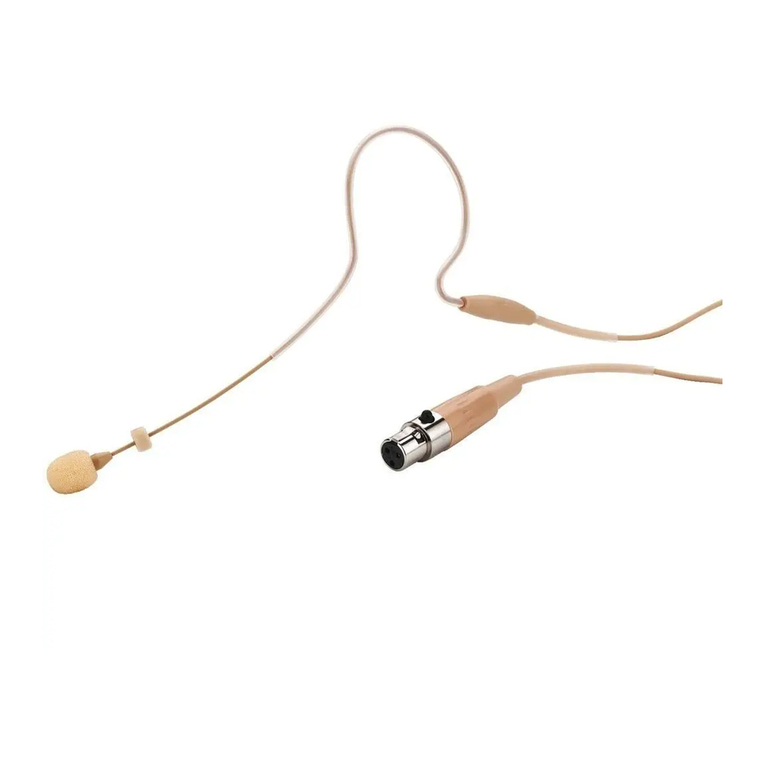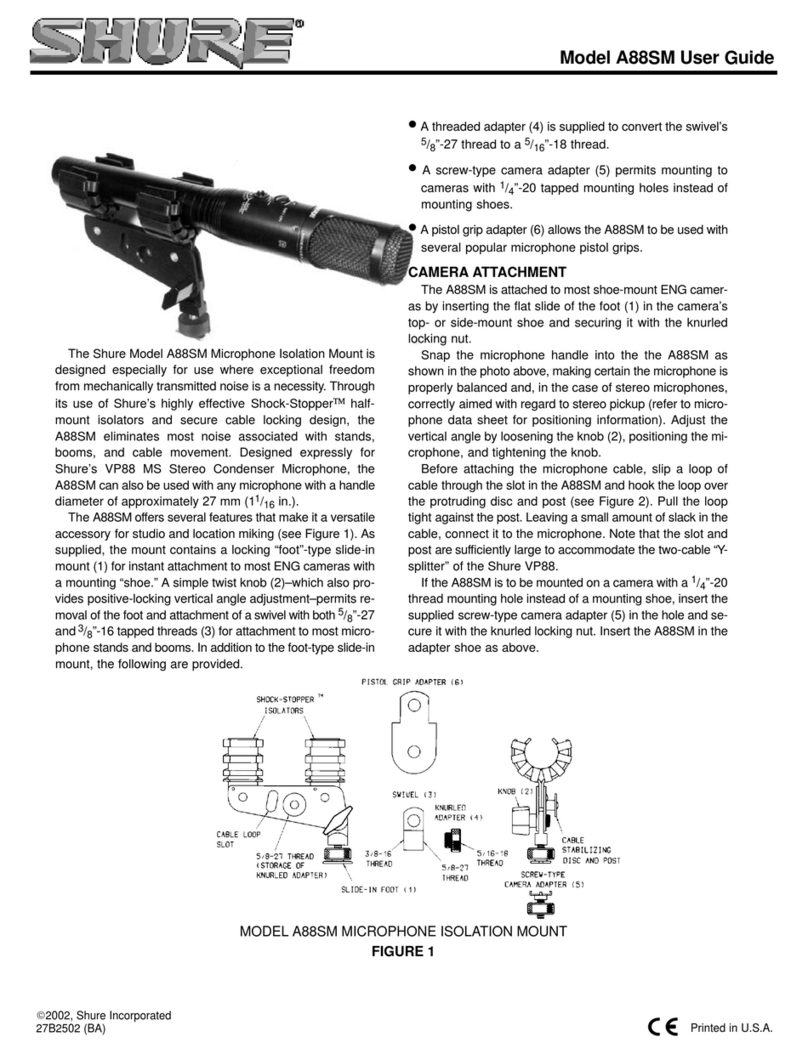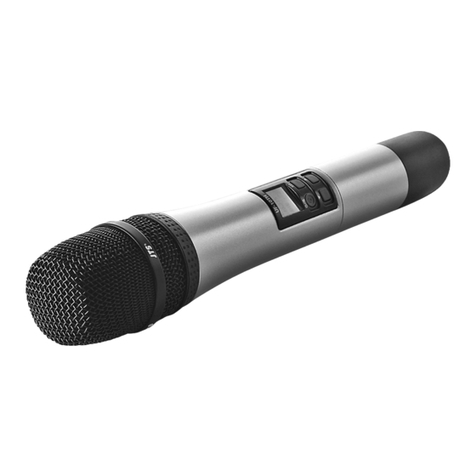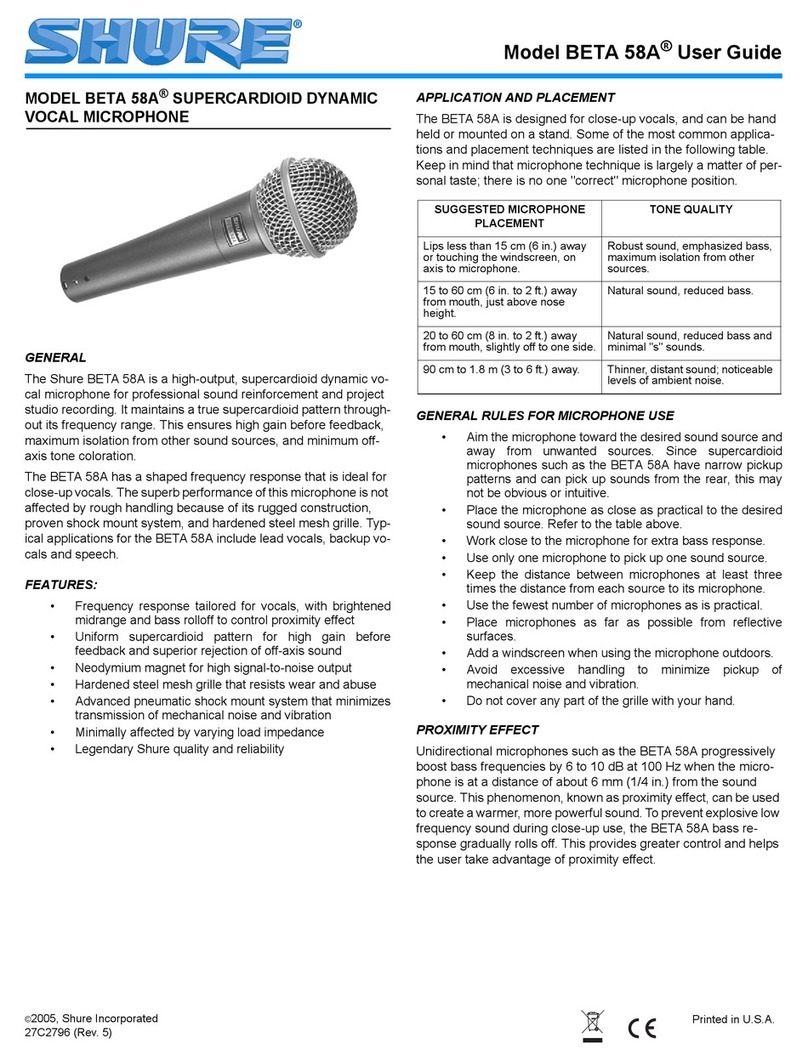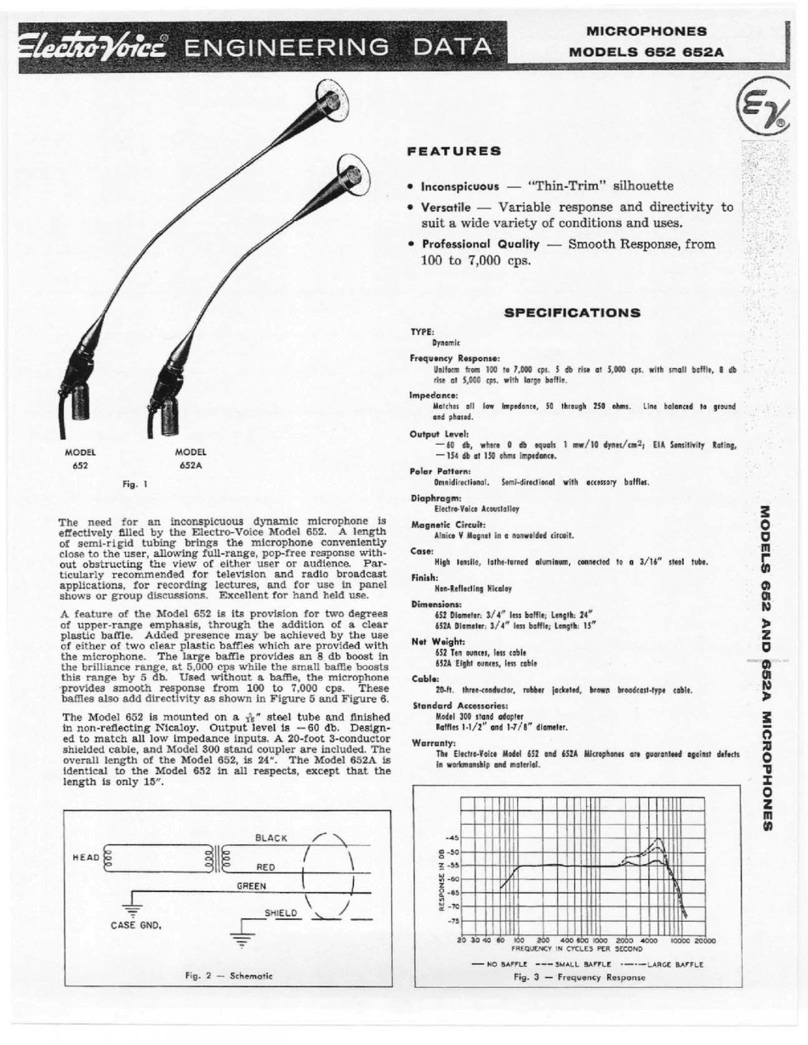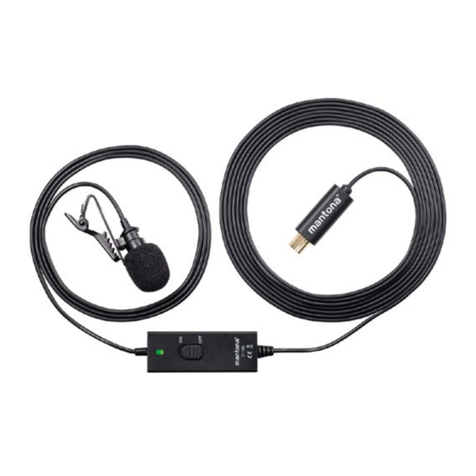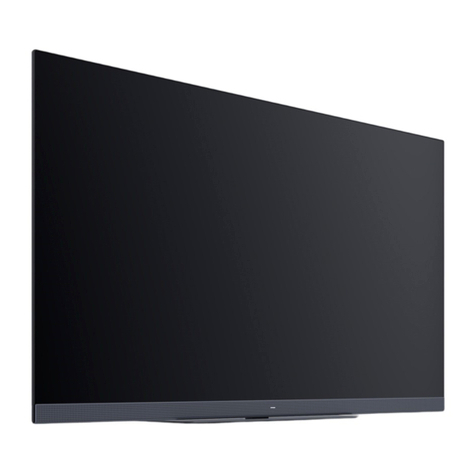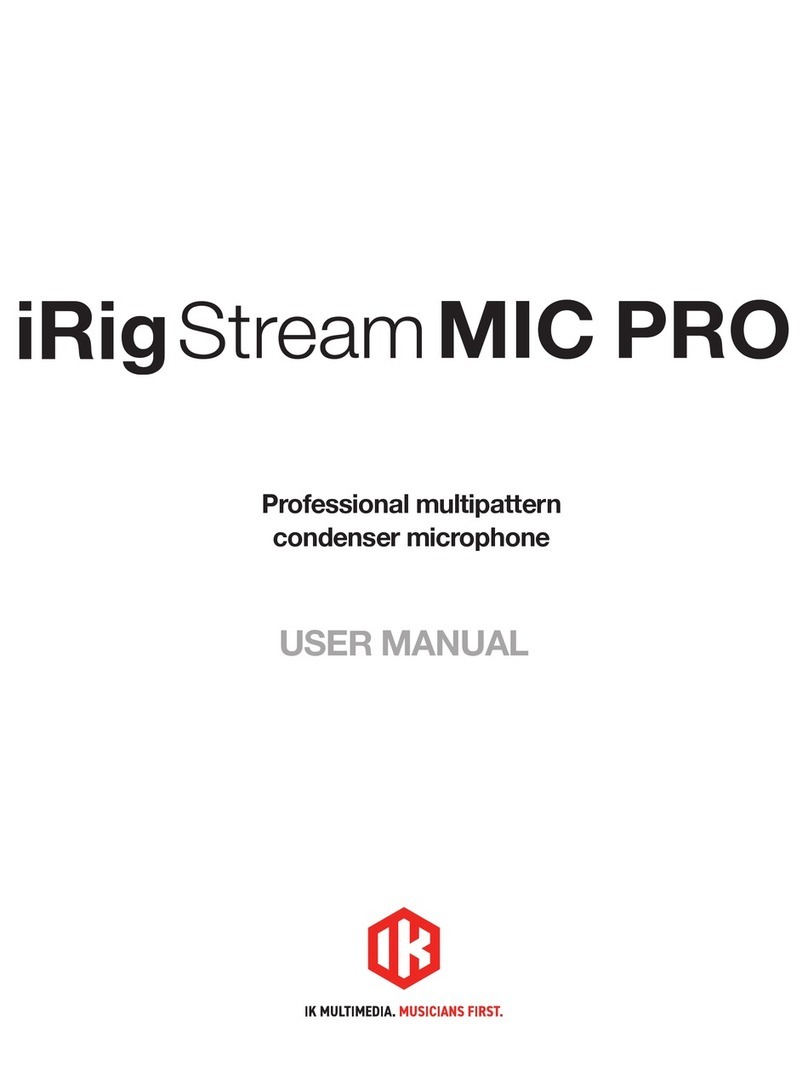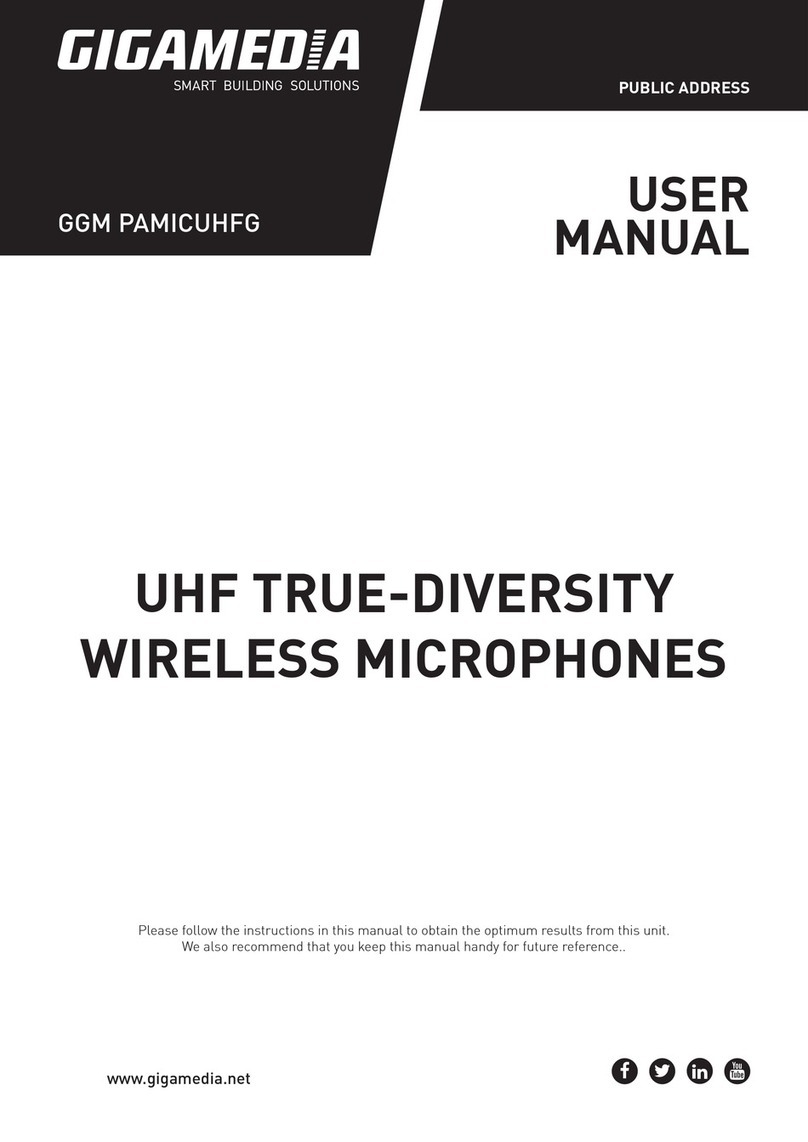
ELECTRONICS FOR SPECIALISTS ELECTRONICS FOR SPECIALISTS ELECTRONICS FOR SPECIALISTS ELECTRONICS FOR SPECIALISTS ELECTRONICS FOR SPECIALISTS ELECTRONICS
ECM-310W
Bestell-Nr. • Order No. 23.3360
MONACOR INTERNATIONAL GmbH & Co. KG • Zum Falsch 36 • 28307 Bremen • Germany
Copyright©by MONACOR INTERNATIONAL. All rights reserved. A-0129.99.03.01.2019
Elektretowy Mikrofon Instrumentowy
Niniejsza instrukcja przeznaczona jest dla użyt-
kowników, którzy nie posiadają wiedzy i do-
świadczenia technicznego. Przed rozpoczęciem
użytkowania proszę zapoznać się z instrukcją, a
następnie zachować ją do wglądu.
1 Zastosowanie
Elektretowy mikrofon instrumentowy ECM-310W jest
przeznaczony do przetwarzania dźwięków na scenie
a w szczególności do przetwarzania dźwięków instru-
mentów dętych. Klamra umożliwia zamocowanie mi-
krofonu do instrumentu w miejscu wydobywania się
dźwięku.
Mikrofon musi być zasilany poprzez dołączone
współpracujące urządzenie audio tzn. gniazdo mi-
krofonowe tego urządzenia musi posiadać zasilanie
fantomowe (⎓9– 48 V). Przejściówka z zasilaniem fan-
tomowym dołączona jest do mikrofonu. Dodatkowo
mikrofon jest wyposażony w plastikowe opakowanie
i wiatrochron.
2 Środki bezpieczeństwa
Mikrofon spełnia wszystkie wymagania norm UE, dla-
tego został oznaczony symbolem .
•
Urządzenie przeznaczone jest wyłącznie do pracy
wewnątrz pomieszczeń. Należy chronić je przed wil-
gocią i wysoką temperaturą. (dopuszczalny zakres
wynosi 0– 40 °C).
•
Do czyszczenia używać suchej miękkiej ściereczki.
Nie stosować wody i środków chemicznych.
•
Producent ani dostawca nie ponoszą odpowiedzial-
ności za uszkodzenie sprzętu bądź obrażenia użyt-
kownika, jeżeli urządzenie było używane niezgodnie
z przeznaczeniem, zostało nieodpowiednio podłą-
czone lub poddane nieautoryzowanej naprawie.
Jeśli mikrofon nie będzie już więcej uży-
wany, wskazane jest przekazanie go do
miejsca utylizacji odpadów, aby został
zniszczony bez szkody dla środowiska.
3 Obsługa
Należy zamocować uchwyt mikrofonu do instrumentu
muzycznego i ustawić gęsią szyję w optymalnej pozy-
cji. W razie potrzeby należy nałożyć wiatrochron.
Przewód mikrofonu należy podłączyć do gniazda
mini XLR dołączonej przejściówki a następnie połączyć
gniazdo XLR przejściówki do symetrycznego wejścia
mikrofonowego XLR. Wejście mikrofonowe musi być
wyposażone w zasilanie fantomowe ⎓9–48 V. W
przeciwnym wypadku obsługa mikrofonu będzie nie-
możliwa.
4 Dane techniczne
Charakterystyka:. . . . . . . . . superkierunkowa
Zakres częstotliwości:. . . . . 30–17 000 Hz
Czułość: . . . . . . . . . . . . . . . . 4,5 mV/Pa przy 1kHz
Impedancja: . . . . . . . . . . . . 200Ω
Maksymalny SPL: . . . . . . . . 120dB
Zasialnie:. . . . . . . . . . . . . . . zasilanie fantomowe
⎓9– 48 V
Długość mikrofonu, waga: 140mm, 155 g
Długość kabla: . . . . . . . . . . 3m
Połączenia
mikrofon: . . . . . . . . . . . . mini XLR, niesymetryczne
przejściówka: . . . . . . . . . mini XLR, niesymetryczne/
XLR, symetryczne
Z zastrzeżeniem możliwość zmian.
Micrófono Electret para Instrumentos
Estas instrucciones van dirigidas a usuarios sin
ningún conocimiento técnico específico. Lea
atentamente las instrucciones antes de utilizar el
micrófono y guárdelas para usos posteriores.
1 Aplicaciones
El micrófono electret para instrumentos ECM-310W
está especialmente fabricado para una utilización en
escenario y es ideal para la toma de sonido de instru-
mentos a viento. Mediante la fijación por pinza puede
colocarse fácilmente en el cono de salida de sonido
del instrumento.
El micrófono está alimentado vía el aparato audio
conectado: la entrada de micrófono del aparato
audio debe disponer de una alimentación phantom
(⎓9 – 48V). Un adaptador de alimentación phantom
para la conexión está entregada con el micrófono.
También está entregada una bolsa de transporte de
plástico y una espuma de protección anti-viento.
2 Notas Importantes
El micrófono cumple con todas las directivas relevantes
de la UE y por lo tanto está marcado con el símbolo .
•
El micrófono está adecuado sólo para utilizarlo en
interiores. Protéjalo de la humedad y del calor (tem-
peratura ambiente admisible: 0– 40 °C).
•
Utilice sólo un paño suave y seco para la limpieza; no
utilice nunca ni agua ni productos químicos.
•
No podrá reclamarse garantía o responsabilidad
alguna por cualquier daño personal o material re-
sultante si el micrófono se utiliza para otros fines di-
ferentes a los originalmente concebidos, si no se co-
necta adecuadamente o si no se repara por expertos.
Si va a poner el micrófono definitivamente
fuera de servicio, llévelo a la planta de re-
ciclaje más cercana para que su eliminación
no sea perjudicial para el medioambiente.
3 Funcionamiento
Fije el soporte micrófono sobre el instrumento, oriente
el cuello de cisne del micrófono de manera óptima.
Si es necesario, ponga la espuma de protección anti-
viento entregada.
Conecte el cable del micrófono con el conector
mini XLR del adaptador de alimentación entregado
y conecte el conector XLR del adaptador con una
entrada de micrófono XLR simétrica. La entrada de
micrófono debe disponer de una alimentación phan-
tom ⎓9– 48 V si no el micrófono no funciona.
4 Especificaciones
Directividad: . . . . . . . . . . . . . . . supercardioide
Rango de frecuencias: . . . . . . . 30–17000 Hz
Sensibilidad: . . . . . . . . . . . . . . . 4,5mV/Pa a 1kHz
Impedancia: . . . . . . . . . . . . . . . 200Ω
Presión sonora máxima:. . . . . . 120dB
Alimentación: . . . . . . . . . . . . . . alimentación phantom
⎓9– 48 V
Longitud del micrófono, peso: 140mm, 155 g
Longitud del cable: . . . . . . . . . 3m
Conexión
Micrófono: . . . . . . . . . . . . . . mini XLR, asimétrica
Adaptador de alimentación: mini XLR, asimétrica/
XLR, simétrica
Sujeto a modificaciones técnicas.
Microfono all’elettrete
per strumenti musicali
Queste istruzioni sono rivolte all’utente senza
conoscenze tecniche specifiche. Vi preghiamo di
leggerle attentamente prima della messa in fun-
zione e di conservarle per un uso futuro.
1 Possibilità d’impiego
Il microfono ECM-310W per strumenti musicali è pre-
visto per l’impiego professionale ed è particolarmente
adatto per la riproduzione di strumenti a fiato. Con
il morsetto può essere fissato comodamente sul padi-
glione dello strumento.
Il microfono viene alimentato attraverso l’apparec-
chio audio collegato; ciò significa che l’ingresso micro-
fono dell’apparecchio audio dev’essere equipaggiato
con alimentazione phantom (⎓9– 48 V). Per il colle-
gamento, un adattatore di alimentazione phantom si
trova in dotazione, come anche una custodia di pla-
stica e una spugna antivento.
2 Avvertenze importanti
Il microfono è conforme a tutte le direttive rilevanti
dell’UE e pertanto porta la sigla .
•
Il microfono è adatto solo per l’uso all’interno di lo-
cali. Proteggerlo dall‘umidità e dal calore (tempera-
tura d’impiego ammessa fra 0 e 40°C).
•
Per la pulizia usare solo un panno morbido, asciutto;
non impiegare mai acqua o prodotti chimici.
•
Nel caso d’uso improprio, di collegamenti sbagliati
o di riparazione non a regola d’arte del microfono,
non si assume nessuna responsabilità per eventuali
danni consequenziali a persone o a cose e non si as-
sume nessuna garanzia per il microfono.
Se si desidera eliminare il microfono defini-
tivamente, consegnarlo per lo smaltimento
ad un’istituzione locale per il riciclaggio.
3 Messa in funzione
Fissare il supporto sullo strumento ed orientare il collo
di cigno del microfono in modo ottimale. Se è necessa-
rio montare la spugna antivento, in dotazione.
Collegare il cavo del microfono con il connettore
mini-XLR dell’adattatore di alimentazione in dota-
zione e collegare il connettore XLR dell’adattatore con
un ingresso microfono XLR simmetrico sull’apparecchio
audio. L’ingresso microfono deve essere equipaggiato
con un’alimentazione phantom ⎓9– 48 V, altrimenti il
microfono non può funzionare.
4 Dati tecnici
Sistema:. . . . . . . . . . . . . . . . . supercardioide
Banda passante: . . . . . . . . . . 30– 17 000Hz
Sensibilità:. . . . . . . . . . . . . . . 4,5mV/Pa a 1 kHz
Impedenza:. . . . . . . . . . . . . . 200 Ω
Pressione sonora max.:. . . . . 120dB
Alimentazione:. . . . . . . . . . . alimentazione phantom
⎓9– 48 V
Lunghezza microfono, peso: 140mm, 155 g
Lunghezza cavo:. . . . . . . . . . 3m
Collegamento
Microfono: . . . . . . . . . . . . mini-XLR, asimm.
Adattatore alimentatore: mini-XLR, asimm./
XLR, simm.
Con riserva di modifiche tecniche.
Italiano
Español
Polski
➁
Risposta di frequenza
Respuesta de frecuencia
Częstotliwość pracy
➀
Caratteristica direzionale
Directividad
Charakterystyka kołowa
